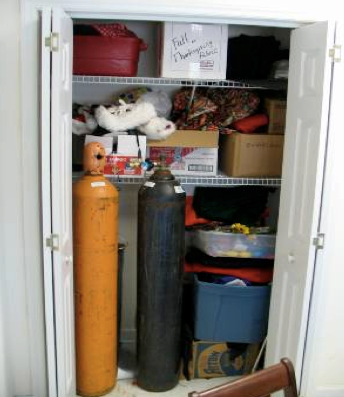Spot The Safety Violation: Improper Hazardous Substance Storage Can Be Deadly
What’s wrong with how these compressed gas cylinders are being stored’

Protecting workers from hazardous substances requires more than just ensuring they’re properly labeled and have appropriate MSDSs/SDSs. You must also properly store such substances, such as by keeping substances that are flammable away from heat sources and separating incompatible substances so they don’t mix if there’s a spill or leak.
In this picture from the Office of the Lee County Fire Marshall in NC, the two cylinders of compressed gas are located in a closet that doesn’t appear to be designed for storage or hazardous substances’or marked with signs, placards or the like to indicate its contents. Also, the cylinders should be strapped or otherwise secured to keep them from falling. Lastly, one of the cylinders is missing its valve cap. So if that cylinder should topple, the results could be disastrous.
Example: In an incident at a construction site in England, a heavy gas cylinder fell over, discharged high pressure gas, collided with other cylinders and set off a chain reaction. As a result, 66 cylinders were propelled around the site at speeds up to 274 km/h, causing one worker’s death and serious injuries to six others. The Health and Safety Executive investigated the incident and found, among other unsafe practices, that 80 cylinders were stored without their protection caps and left unsecured. Three companies involved in the incident were ultimately convicted of safety offences and fined a total equivalent to more than $1 million.
And it’s not just compressed gas cylinders that are a danger. Containers of other hazardous substances must also be properly stored or result in similar consequences.
Example: An Ontario company operated a propane filling and distribution centre where a fire occurred, damaging about 30,000 propane tanks and three trucks. Luckily, no one was hurt. An investigation revealed that the company stored leaking, damaged and corroded cylinders. It also stored improperly overfilled cylinders instead of emptying these cylinders. The company pleaded guilty to storage-related violations of the OHS laws and the laws governing propane storage and handling and was fined $55,000 [Vomar Industries Inc., Govt. News Release, March 28, 2014].
6 Key Elements of Safe Hazardous Substances Storage
You should always consult the requirements for storage of hazardous substances in your jurisdiction’s OHS law. (You should also check the environmental laws, which may have storage requirements that apply to certain types and/or amounts of hazardous substances and types of storage containers, such as underground storage tanks.) But there are six basic elements of safe storage:
1. Inventory. Take an inventory to determine exactly how many hazardous substances are used, handled or stored in your workplace, what kinds and in what amounts. (Adapt and use this model hazardous substance inventory form.)
2. Storage area. Designate an appropriate area for storage of hazardous substances. Your storage area can be as small as a cabinet or as large as an entire room or even a building. The designated area should meet certain criteria, such as it should be fire-resistant and have adequate ventilation and lighting. (The closet in the picture probably doesn’t meet these criteria.)
3. Quantities. To reduce the effects of any incident involving hazardous substances, try to limit the quantities you keep on-hand.
4. Storage methods. Within the designated area, ensure that safe methods are used to store the hazardous substances. For example, keep incompatible substances separate, ensure containers aren’t damaged and store heavy containers are lower shelves. And gas cylinders such as the ones in the picture should be strapped or braced to prevent them from falling.
5. Labels. Make sure that all containers of hazardous substances are properly labeled. Replace any labels that are missing, damaged or illegible. (Substances considered ‘controlled products’ under WHMIS must have appropriate supplier and/or employer labels.)
6. Signs. The storage area, room, cabinet or building should be clearly identified as containing hazardous substances with signs, placards or similar means of identification. (In the picture, there don’t appear to be any signs on the doors or walls near the closet warning that hazardous substances were being stored inside.)